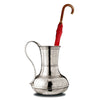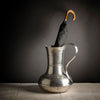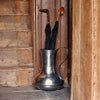Umbra Umbrella Stand - 43 cm Height - Handcrafted in Italy - Pewter
Handcrafted from solid pewter by Italian artisans, this classic hallway object is majestic in its simplicity. The soft hue of the pewter's warm patina suits the gentle generous curves of the broad solid base which gracefully elongates and flutes with its substantial height. Umbrellas simply look at home within this gorgeous vessel.
Buying as a gift? Why not make it even more special with our engraving service?
This ample vessel can accommodate all these different types of umbrellas, one for each member of the household and more; the redundant parasol, sacred walking sticks, jolly hockey sticks, split cane fishing rods and even a hobby horse or two...
Or, if you are lucky enough not to feel the need to keep an umbrella, this super-sized vessel makes a stunning centre-piece for displaying fresh or dry flowers...
UMBRELLA HISTORY
The word umbrella, known as umbraculum to the Romans, comes from the Latin ‘ombra’ meaning shade or shadow, which has provided other related terms – such as ‘sombre’ – being under a shadow, and ‘sombrero’ - a shady hat. These early umbrellas were made of skin or leather, and were still of similar design in Renaissance times, and were thought to have been used in Spain & Portugal within the same period, which would explain how they were seen within the New World at the same time. For example; Daniel Defoe references them; Crusoe recreates an umbrella like those he has seen in South America, and subsequently, one type of umbrella has become known as "The Robinson."
By the 18th Century, in the inclement climate of Northern European countries, it became the norm for well-off women to carry umbrellas against the rain. These umbrellas were typically made of feather, to replicate the plumage of water resistant birds. Men were rarely seen with umbrellas, however, as it was viewed as an effeminate accessory, yet times were changing, albeit very slowly, and men would sometimes use umbrellas, yet only under the cover of darkness, and whilst wearing a mask! By the end of the 18th Century, umbrellas for men had been popularized by writer Jonas Hanway; he claimed his delicate constitution justified using an umbrella, so English gentleman came to call their umbrellas ‘Hanways’.
After feathers, oiled silk was used, yet this was not particularly practical either, these umbrellas were heavy and difficult to open and close,so eventually silk and gingham became the material of choice, they were lighter and so easier to carry, often with a ring on the top to be held by ones finger and be hung upon a peg. Throughout the 19th Century the umbrella was seen as practical and decorative accessory, with the first umbrella shop; James Smith & Sons, opening in 1830, and still in existence today in New Oxford Street London, with specialist handles; of bone, ebony and ivory, and ornate shades, gradually evolving into the metal framed versions we are familiar with today.
The Victorian era also saw the golden age of the parasol - the umbrella’s cousin – although ancient in design, it was extremely popular due to the fashion at the time for female fair complexion. Pale skin was seen as a marker within women of both beauty and class. Refined ladies did not have to work outdoors, unlike their working class counterparts; their pale complexions a representation of their cossetted existence. The parasol was a fashionable accessory, into the 20th Century, along with the lace handkerchief and fan, all of which were cleverly used as aids to flirting within high society.
Fast forward until today, and out of necessity, every British household, to cope with our inclement climate, has its selection of umbrellas; generous golf ones, for the not so fair fairway or for family huddles in puddles, stylish pretty ones for soggy shopping trips, black ones for wet workdays, sombre ones for reverent and respectful occasions and bright and funky ones for child's play whether it is raining or not.
Size: Diameter 35 cm x Height 43 cm
Weight: 5760 g
Materials Used: Pewter
Ref: CT0105601
Designer: Alberto Tabellini
100% Lead Free
All Cosi Tabellini Pewter is 100% lead-free, so it is totally food & drink safe, and is both EU and US FDA approved.
Packaging
Cosi Tabellini pieces come gift-boxed with a guarantee card and instructions on how to care for pewter.





